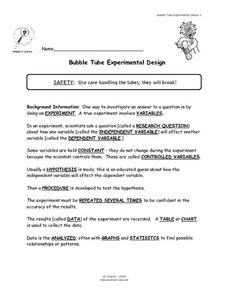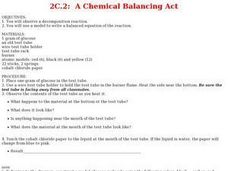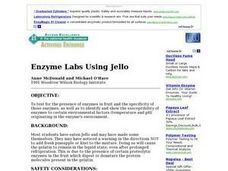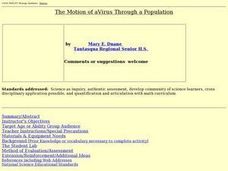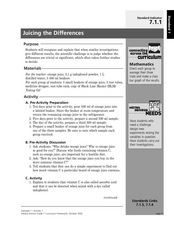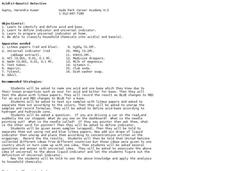Curated OER
Bubble Tube Experimental Design
Students study what an experiment is comprised of and how to be successful when doing an experiment. In this experimental lesson plan students design their own experimental investigation and answer questions.
Curated OER
A Chemical Balancing Act
Learners decompose glucose and write an equation for the reaction. In this decomposition reaction lesson plan, students burn a sample of glucose and test the products for water using cobalt chloride paper. They write a balanced equation...
Curated OER
How Much Oxygen Is In The Air?
In this science worksheet, students take a close look at the composition of air while focusing on the content of oxygen. They use clay to model the amounts.
Curated OER
Nutrient Analysis Lab
In this nutrient analysis lab worksheet, students perform several experiments in a lab setting. Students test products for carbohydrates (monosaccharides and polysaccharides), proteins, lipids, and starches.
Curated OER
The Determination of the Presence of Reducing Sugars Using Fehling's Solution
Students investigate different fruits and vegetables for the presence of sugars. In this sugars and Fehling's solution lesson, students test the juice from an onion and a lemon for the presence of sugar by adding Fehling's solution and...
Curated OER
Solubility Lab
In this solubility worksheet, students test a variety of polar and non polar substances to determine which ones will dissolve in vegetable oil and which ones will dissolve in water. Students collect data and answer 2 questions about...
Creative Chemistry
The Chemical Detective
In this chemical detectives learning exercise, students perform six tests on various unknown solutions, including a test for chloride ions, sulphate ions, carbonate ions, iron (III) ions, iron (II) ions, and copper (II) ions. Students...
Curated OER
Acids, Bases, and Buffers
In this acids and bases worksheet, students test the pH of different solutions to determine if it is basic or acidic. Students complete 7 short answer questions based on their results.
Curated OER
Enzyme Labs Using Jello
Students test for the presence of enzymes in fruit and the specificity of those enzymes, as well as to identify and show the susceptibility of enzymes to certain environmental factors (temperature and pH) originating in the enzyme's...
Curated OER
The Motion of a Virus Through a Population
Students test the factors that influence the rate at which a virus spreads through a population. They complete a lab activity then discuss data collected and review and answer a set of questions.
Curated OER
Characteristics of Matter
Students study matter. In this science lesson plan, students examine the relationships among gravity, weight, and mass, the metric measurement of distance and volume, and density and its application to physical properties.
Curated OER
The Frigid Gourmet
Young scholars make a " science surprise" or ice cream in the lab. In this melting point depression lesson plan, students use various substances with ice to determine the effects on the melting point of ice and the ability to make ice...
Curated OER
Acid/Base Indicators
Students use plant materials as indicators of acids and bases. In this acid/base indicators lesson plan, students use boiled beets, cabbage, flowers, teas or berries that have been boiled with alcohol to test various acids and bases....
Curated OER
DNA Extraction Lab
Students extract DNA and test for its presence from unroasted (raw) wheat germ using a prescribed procedure. They modify the procedure to provide a less expensive, easier method. They also extract DNA from different available plant,...
Curated OER
Acids, Bases and Indicators
Students investigate the pH of various solutions with indicators. In this acids, bases and indicators lesson plan, students use a variety of indicators to test solutions for their pH. Students determine which indicators are the best to...
Curated OER
Introduction to Gases
Students are introduced to gases. In this science lesson plan, students demonstrate that gases are a state of matter, generate a number of gases, discover some properties of gases, compare some of the properties of different gases, and...
Curated OER
Juicing the Differences
Seventh graders investigate the vitamin C content of orange juice. In this chemistry lesson, 7th graders analyze the variables that cause result variation in their experiment. They design a new experiment to test variables in question.
Creative Chemistry
Oxidation of Ethanol to Ethanoic Acid
Learners covert ethanol to ethanoic acid using a condenser for this oxidation reaction worksheet. They test the smell of the final product, add sodium carbonate, and test the product with indicator paper. They explain their observations...
Curated OER
Observation and Stimulation of bioluminescence and chemiluminescence
Students are introduced to chemical reactions, reaction rates, chemiluminescence, fluorescence and bioluminescence. They use glow sticks are used to demonstrate the effect of temperature on the rates of chemical reactions. Pupils recall...
Curated OER
Introductory Lesson on How pH Levels are Determined
Young scholars explore pH levels of different substances. In this instructional activity about pH, students work together in three to four groups to test substances. moving between three different stations performing tests on the...
Curated OER
Acid(s)-Base(s) Detective
High schoolers investigate acids, bases, indicators and universal indicators. In this acid and base lesson plan, students test 6 samples with litmus paper and determine if they are acids or bases. They separate out 7 samples using litmus...
Curated OER
Chemical Sleuthing
Students engage in a lesson which includes flame tests and the construction of a simple diffraction spectrograph with which to measure sodium ion emissions. They use the Bragg equation to compute the wavelength of the line spectra produced.
Curated OER
Talking Tubes
Students study the theory that sound travels through a variety of instruments. They explore all the channels of the ear and its various purposes. Students test objects to see which ones were vibrating to make sound heard.
University of Georgia
Heating and Cooling of Land Forms
Compare heating and cooling rates of different land forms. A lab activity has groups collect data on the rate of heating and cooling of soil, grass, saltwater, fresh water, and sand. An analysis of the rates shows how the different land...
